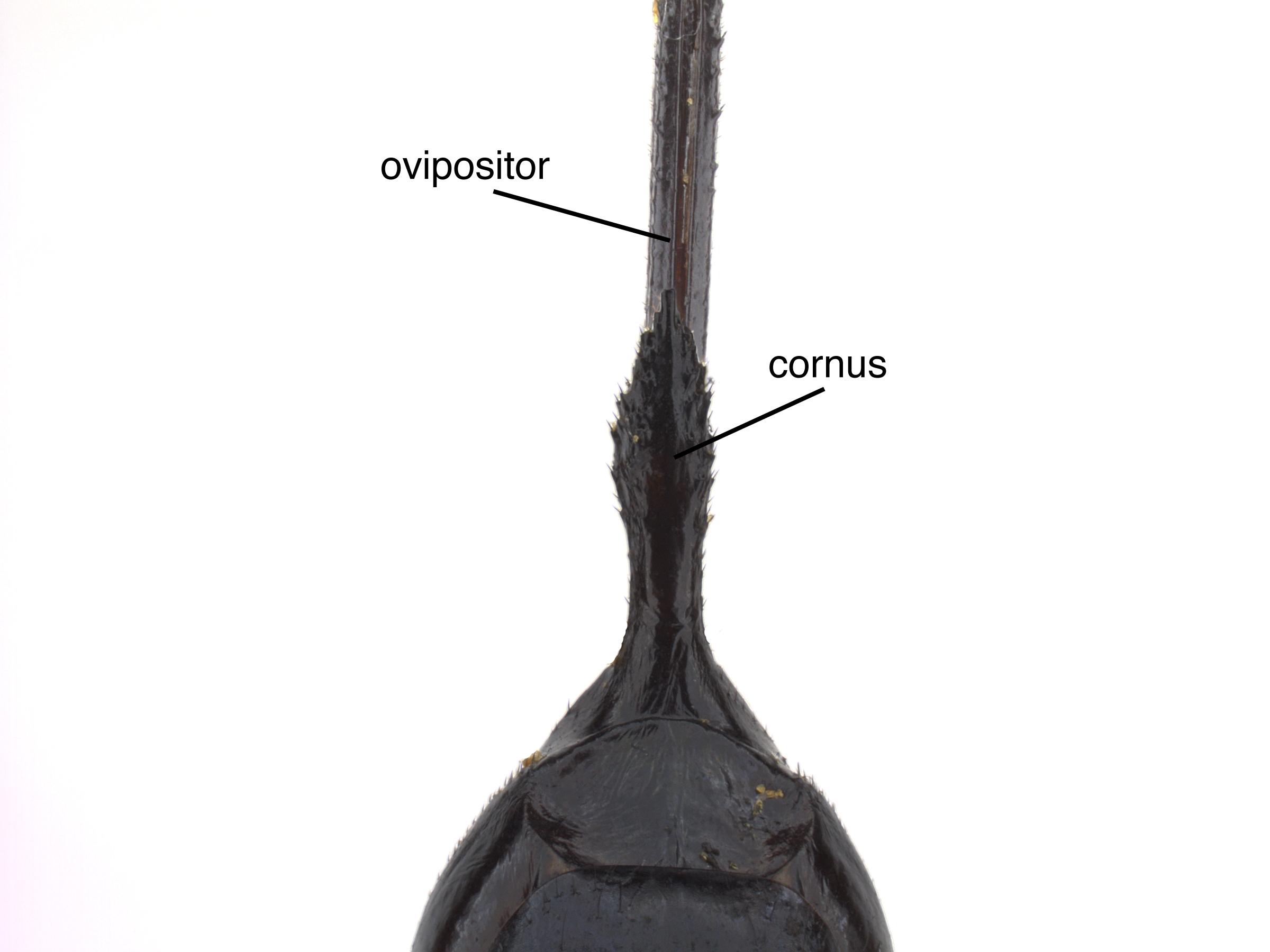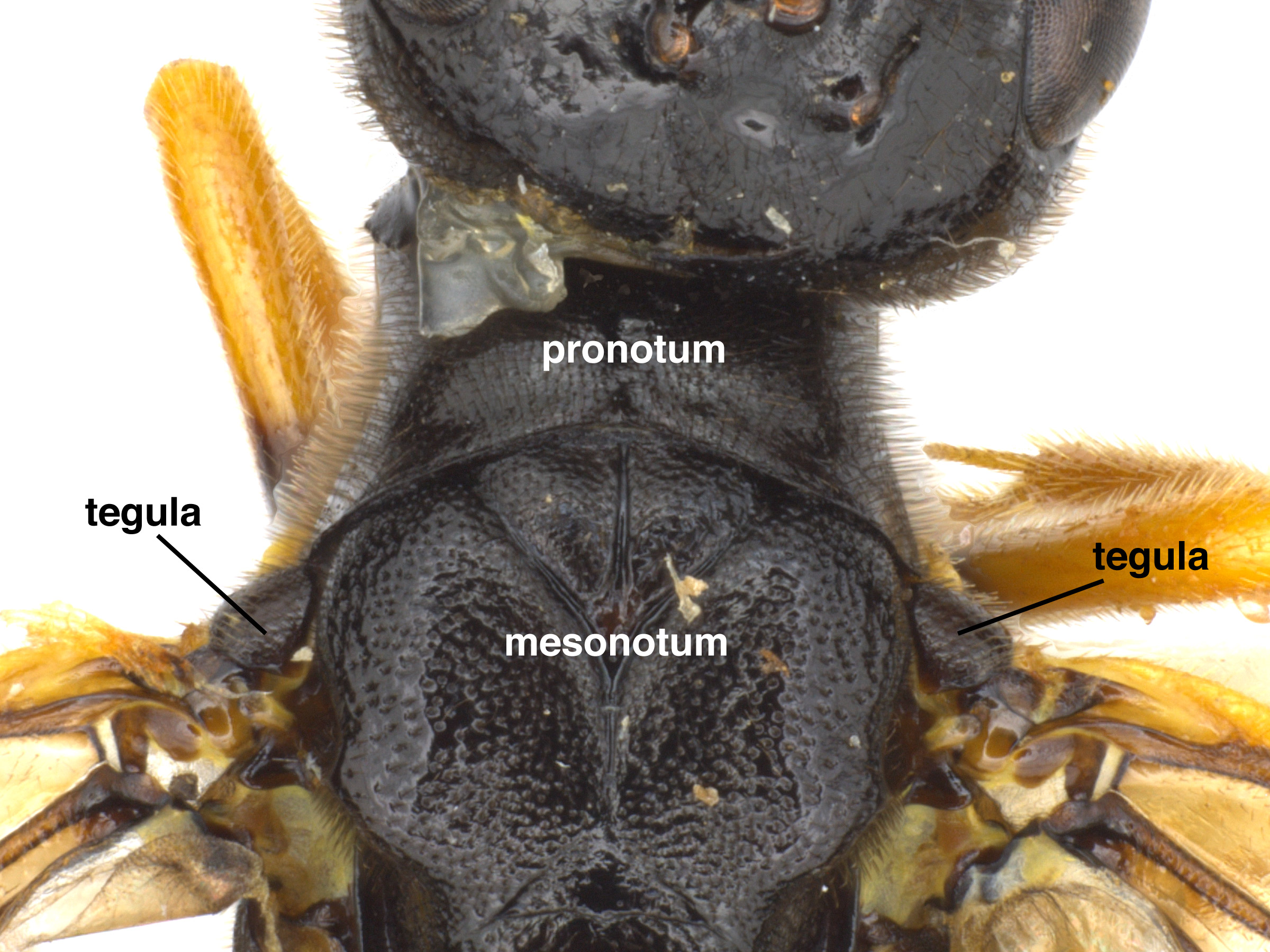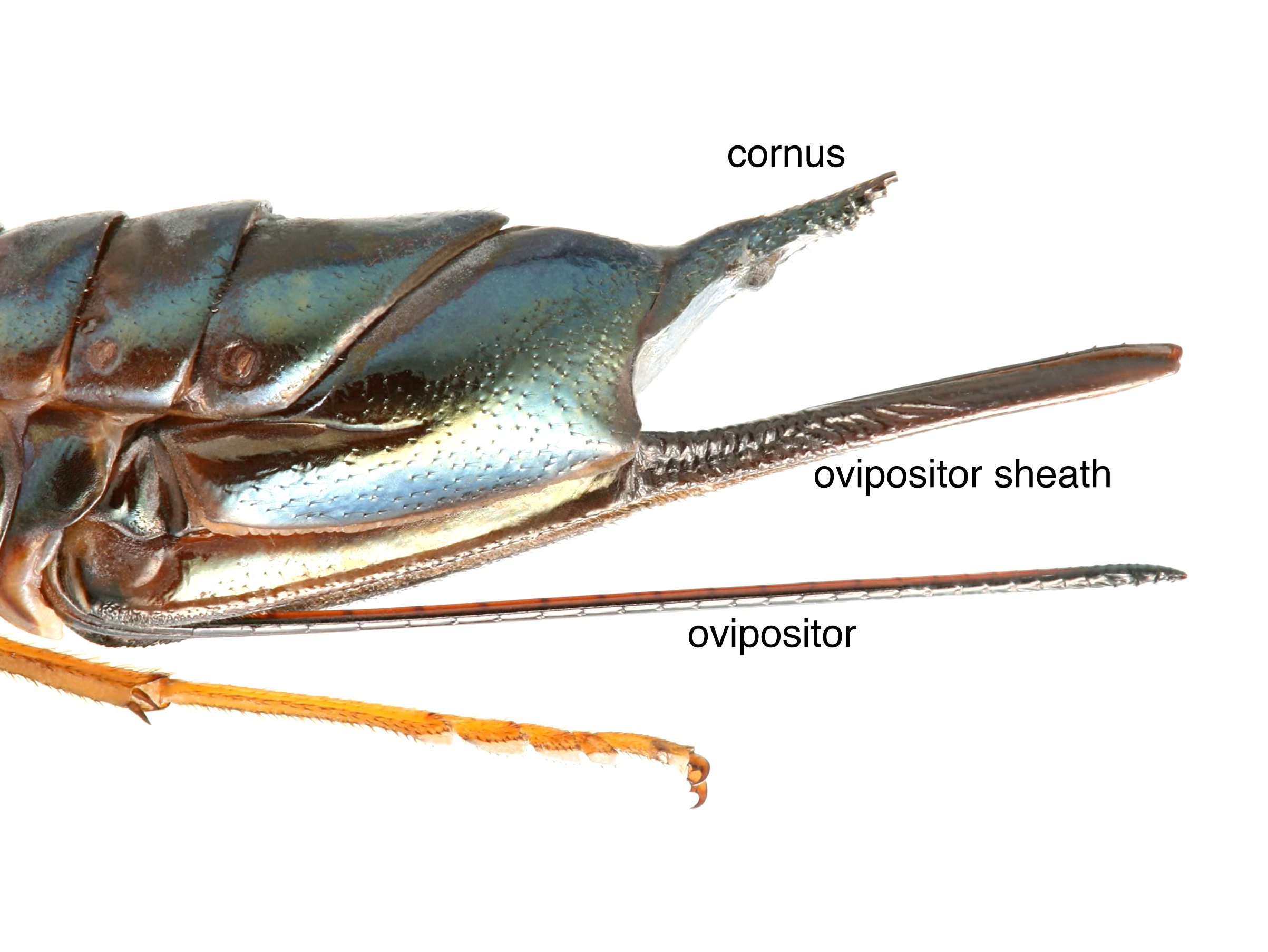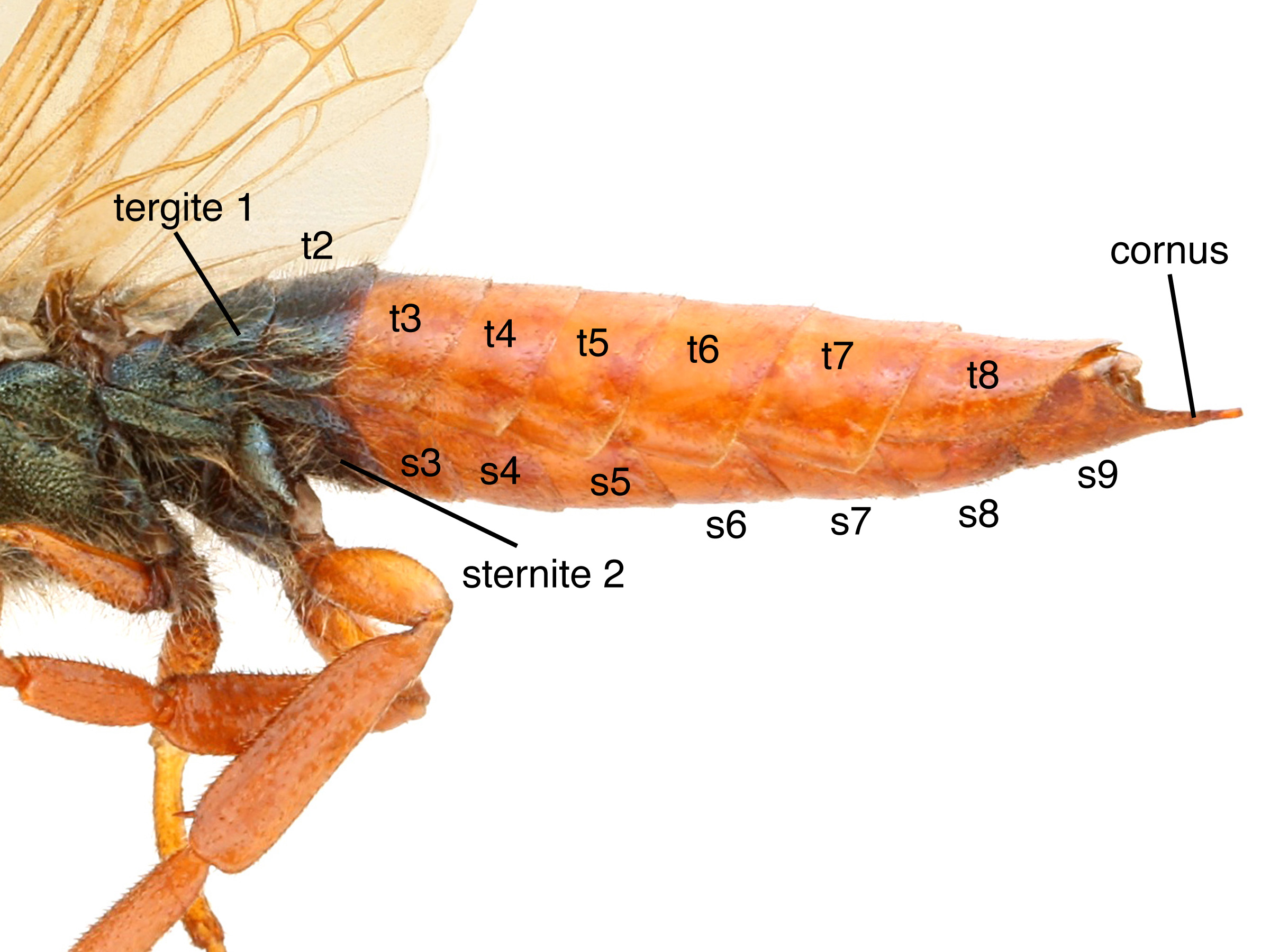Superfamily: Siricoidea
Family: Siricidae
Family common name: horntails and wood wasps
Subfamilies: Auliscinae, Gigasiricinae, Siricinae, Tremicinae
The family Siricidae is represented in North America by two subfamilies (Goulet 1992Goulet 1992:
Goulet H. 1992. The genera and subgenera of the sawflies of Canada and Alaska: Hymenoptera. Symphyta. The insects and arachnids of Canada. Part 20. Agriculture Canada Publication.). All horntail species are wood-borers as larvaelarva:
the immature stage of holometabolous insects
 that feed on symbiotic wood-decaying fungus. Some species are economic pests of trees grown for lumber. This family is fairly easy to recognize by the large pointed cornuscornus:
that feed on symbiotic wood-decaying fungus. Some species are economic pests of trees grown for lumber. This family is fairly easy to recognize by the large pointed cornuscornus:
a pointed horn-like process on the apical end of the abdomen in Siricidae sawflies; on tergite 10 in females, sternite 9 in males
 and the large collar-like pronotumpronotum:
and the large collar-like pronotumpronotum:
the anterodorsal part of the thorax, often situated posterior to the head
 (Goulet 1992Goulet 1992:
(Goulet 1992Goulet 1992:
Goulet H. 1992. The genera and subgenera of the sawflies of Canada and Alaska: Hymenoptera. Symphyta. The insects and arachnids of Canada. Part 20. Agriculture Canada Publication.). Many species are large and have either metallic coloring, bright yellow patterning, or exceedingly long and obvious ovipositorovipositor:
the female organ that deposits eggs and is used to drill into plant tissue, located at the apex of the abdomen, made up of the lance and lancet
 sheaths that look like a wasp’s stinger (Schiff et al. 2012Schiff et al. 2012:
sheaths that look like a wasp’s stinger (Schiff et al. 2012Schiff et al. 2012:
Schiff NM, Goulet H, Smith DR, Boudreault C, Wilson AD, and Scheffler BE. 2012. Siricidae (Hymenoptera: Symphyta: Siricoidea) of the Western Hemisphere. Canadian Journal of Arthropod Identification 21: 1-305.).
Siricidae includes 20 genera and 124 species worldwide. Five genera and 27 species are NearcticNearctic:
describing the region of the Northern Hemisphere that includes North America south through northern Mexico
 in distribution (Taeger et al. 2018Taeger et al. 2018:
in distribution (Taeger et al. 2018Taeger et al. 2018:
Taeger A, Liston AD, Prous M, Groll EK, Gehroldt T, and Blank SM. 2018. ECatSymmdash;Electronic World Catalog of Symphyta (Insecta, Hymenoptera). Program version 5.0 (19 Dec 2018), data version 40 (23 Sep 2018). Senckenberg Deutsches Entomologisches Institut (SDEI), Muuml;ncheberg. https://sdei.de/ecatsym/ Accessed: 28 Jan 2020.).
Eriotremex
Sirex
Tremex
Urocerus
Xeris
 large, with laterallateral:
large, with laterallateral: short ventrally (Goulet 1992Goulet 1992:
short ventrally (Goulet 1992Goulet 1992: sheath long, thin, and pointed (Goulet 1992Goulet 1992:
sheath long, thin, and pointed (Goulet 1992Goulet 1992: obvious and pointed (Goulet 1992Goulet 1992:
obvious and pointed (Goulet 1992Goulet 1992: divided medially (Goulet 1992Goulet 1992:
divided medially (Goulet 1992Goulet 1992:The subfamily Siricinae feeds on coniferconifer:
a usually evergreen tree characterized by reproductive cones; e.g., pine, fir, spruce, larch, etc.
trees from the families Pinaceae and Cupresaceae. Tremicinae species feeds on angiosperm trees including species from the families Aceraceae, Fabaceae, Fagaceae, Rosaceae, Salicaceae, Ulmaceae, and Betulaceae (Smith and Middlekauff 1987Smith and Middlekauff 1987:
Smith DR and Middlekauff WW. 1987. Suborder Symphyta. In: Stehr FW ed. Immature Insects. Kendall/Hunt Publishing Company. Vol. 1: 754 pp., Schiff et al 2012).
Siricidae can be distinguished from other Siricoidea families by the distinctly collar-like pronotumpronotum:
the anterodorsal part of the thorax, often situated posterior to the head
 and the pointed cornuscornus:
and the pointed cornuscornus:
a pointed horn-like process on the apical end of the abdomen in Siricidae sawflies; on tergite 10 in females, sternite 9 in males
 (Goulet 1992Goulet 1992:
(Goulet 1992Goulet 1992:
Goulet H. 1992. The genera and subgenera of the sawflies of Canada and Alaska: Hymenoptera. Symphyta. The insects and arachnids of Canada. Part 20. Agriculture Canada Publication.).
Siricidae in North America are wood borers. Usually they oviposit into decayed or damaged wood while also depositing a symbiotic wood-decaying fungus. The developing larvaelarva:
the immature stage of holometabolous insects
 feed on the fungus (Schiff et al. 2012Schiff et al. 2012:
feed on the fungus (Schiff et al. 2012Schiff et al. 2012:
Schiff NM, Goulet H, Smith DR, Boudreault C, Wilson AD, and Scheffler BE. 2012. Siricidae (Hymenoptera: Symphyta: Siricoidea) of the Western Hemisphere. Canadian Journal of Arthropod Identification 21: 1-305.).
Sirex noctilio is an example of a horntail pest with extensive economic impact.
World: The range of the family includes Europe, Asia, and North America. Sirex noctilio has been introduced and is established in South America, South Africa, and Australia (Schiff et al. 2012Schiff et al. 2012:
Schiff NM, Goulet H, Smith DR, Boudreault C, Wilson AD, and Scheffler BE. 2012. Siricidae (Hymenoptera: Symphyta: Siricoidea) of the Western Hemisphere. Canadian Journal of Arthropod Identification 21: 1-305.).
North America: The Siricidae occurs throughout forested regions of Canada and the United States as far north as Alaska, south into Mexico and the Caribbean (Schiff et al. 2012Schiff et al. 2012:
Schiff NM, Goulet H, Smith DR, Boudreault C, Wilson AD, and Scheffler BE. 2012. Siricidae (Hymenoptera: Symphyta: Siricoidea) of the Western Hemisphere. Canadian Journal of Arthropod Identification 21: 1-305.).